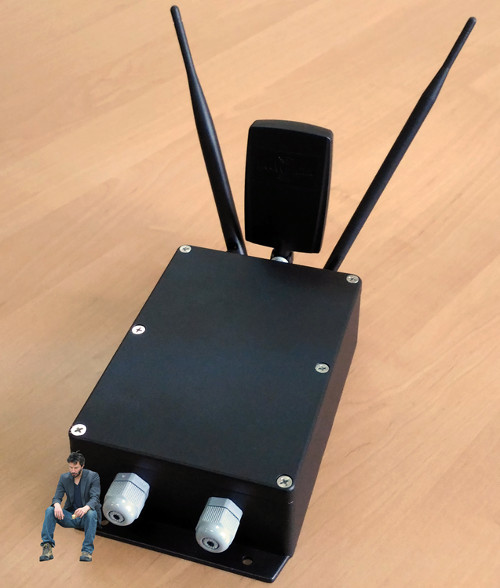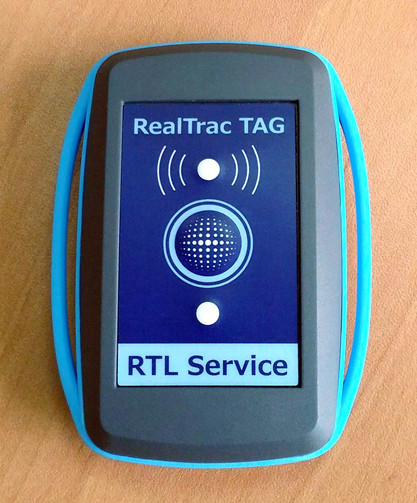Proximity detection system based on UWB technology
A little about UWB ..
Most modern radio standards for data transmission operate within a fairly narrow band of frequencies, namely, they allow quite small deviations from the so-called base (or carrier) frequency.
According to the Shannon-Hartley theorem, it is the bandwidth that determines the channel capacity of the radio system. An alternative way to increase the capacity of the information channel may be an increase in the power of the output signal, however, this is not so effective and is not always possible.
Due to the development of information systems and the demand for them, the problem of increasing the speed of data transmission in radar systems is becoming increasingly important, both for radio communications and for radar. In recent years, this has led to the development of technology using ultra-wideband (UWB) signals - the UWB radio standard (Ultra-Wide Band, IEEE 802.15.4a ).
UWB signals are most often short pulses, the entire energy of which is distributed over a given sufficiently wide part of the spectrum. The data, in turn, is encoded by the polarity and relative position of the pulses. As a result, possessing a sufficiently high total broadcast power and combining such qualities as low power consumption and the pulsed nature of data transmission, we obtain a high data transfer rate. At the same time, such a signal practically does not interfere with other communications, despite the fact that it occupies, in particular, sections of the spectrum already reserved for other standards. The reason for this is the signal strength - at each particular point of the spectrum (ie, at each specific licensed frequency band) the UWB signal does not exceed the extremely low, many times smaller than that of narrowband signals, the values are:

')
The UWB-signal is determined by the decision of the State Committee for Radio Frequency (State Radio Frequency Commission) of the Russian Federation of 2009 as any signal in the range of 3.1 - 10.6 GHz with a spectrum width of more than 500 MHz. In this operating range, the signal power spectral density is limited to -41.5 dBm / MHz. On the one hand, such power limits the use of technology in range, on the other, it indicates a weak signal level, which practically merges with the noise level, so UWB signals do not need to be licensed.
Features of UWB technology:
● High speed of information transfer;
● High noise immunity;
● High electromagnetic compatibility;
● Communication stability in conditions of multipath propagation of radio waves;
● High degree of communication protection from interception;
● The ability to easily penetrate obstacles;
● Technical simplicity of equipment and its cheapness.
If we talk specifically about the use of technology in positioning systems, then on the basis of UWB, highly efficient systems are successfully created for detecting objects in a given zone.
The use of a wide frequency band and a large number of ultrashort pulses, in contrast to systems using narrow-band signals, makes it possible to ensure high spatial resolution in terms of the accuracy of measuring the distance to the target.
Next, we consider the use of UWB technology on the example of our development RealTrac PDS.
Using UWB in RealTrac
RealTrac PDS (Proximity Detection System) is a system for preventing rendezvous with unsafe objects and issuing a warning to personnel about dangerous situations.
The created solution can be used in construction, manufacturing, mining, and other areas: wherever large-sized equipment with limited viewing conditions is used or other objects dangerous for convergence.
Structurally, RealTrac PDS system consists of two components:
1) RealTrac Vehicle Tag (a label that is installed on an object that is dangerous to approach)

The label provides the location of the transport or other unsafe object for the approach and the transfer of coordinates to the server.
At the moment, the label is equipped with interfaces for connecting external equipment and sensors, such as:
● Strobe;
● Beep;
● Siren;
● LED indicator;
● GPO lines;
● Dry contacts.
2) RealTrac Tag (tag worn by staff).

Mobile radio device that measures distances to stationary and mobile objects, and allows you to determine the location of a person.
The system measures distances using two radio standards:
- IEEE 802.15.4a CSS (Chirp Spread Spectrum), 2.4 GHz, at distances from 20 to 400 meters, the measurement accuracy of distances is 1-3 meters
- IEEE 802.15.4a UWB (Ultra Wide Band), 6.0 - 7.0 GHz, at distances up to 25 meters, the measurement accuracy of distances is 0.5 - 1 meter.
The use of two radio standards based on devices is due to the fact that CSS technology is used as a data transmission channel and for integration into the RealTrac local positioning system; UWB is selected as the technology that allows to obtain the highest accuracy of measurements for this task.
Principle of operation
The Vehicle Tag is installed on an object that is unsafe for rendezvous, and is programmatically configured according to the specifics of the problem being solved.
Currently, the Vehicle Tag has the functionality to store lists in non-volatile memory containing information on the policy of finding certain labels in the forbidden zone, the size of this zone for each label, the status of external connection interfaces and many other parameters specific to each task.
Realtrac Tag devices are distributed to staff.
On a specialized radio channel, the distance between the Vehicle Tag and Realtrac Tag is measured, and in case of crossing the danger zone, an alarm is generated: a siren is turned on, a searchlight, various warnings, etc. are generated.
The system can function both independently and as part of the RealTrac local positioning system.
RealTrac PDS in the positioning client software:

Posted by: Victor Pushkarev (corvi)
Source: https://habr.com/ru/post/282698/
All Articles